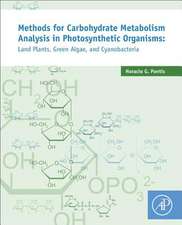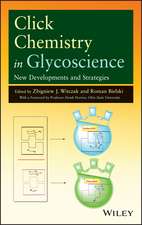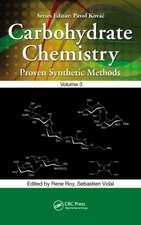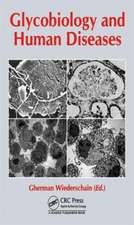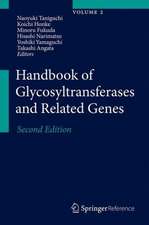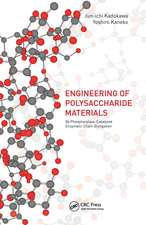Glycobiology: Methods in Enzymology, cartea 480
Minoru Fukudaen Limba Engleză Hardback – 24 oct 2010
- Each chapter has been designed so that enough scientific background will be given in each chapter for further development of methods by readers themselves
- Useful for all levels of scientists starting from the last years of colleges, graduate students, postdoctoral fellows to professors and to all levels of scientists in research institutes including industry
Din seria Methods in Enzymology
-
 Preț: 390.54 lei
Preț: 390.54 lei -
 Preț: 391.30 lei
Preț: 391.30 lei -
 Preț: 392.01 lei
Preț: 392.01 lei -
 Preț: 391.01 lei
Preț: 391.01 lei - 28%
 Preț: 801.23 lei
Preț: 801.23 lei - 32%
 Preț: 802.54 lei
Preț: 802.54 lei - 23%
 Preț: 461.36 lei
Preț: 461.36 lei - 23%
 Preț: 460.60 lei
Preț: 460.60 lei - 23%
 Preț: 439.86 lei
Preț: 439.86 lei - 23%
 Preț: 448.15 lei
Preț: 448.15 lei - 23%
 Preț: 451.42 lei
Preț: 451.42 lei - 23%
 Preț: 445.18 lei
Preț: 445.18 lei - 5%
 Preț: 557.15 lei
Preț: 557.15 lei - 23%
 Preț: 450.67 lei
Preț: 450.67 lei - 23%
 Preț: 446.23 lei
Preț: 446.23 lei - 23%
 Preț: 435.87 lei
Preț: 435.87 lei - 23%
 Preț: 445.94 lei
Preț: 445.94 lei - 23%
 Preț: 459.55 lei
Preț: 459.55 lei - 23%
 Preț: 460.02 lei
Preț: 460.02 lei - 23%
 Preț: 450.54 lei
Preț: 450.54 lei - 23%
 Preț: 453.47 lei
Preț: 453.47 lei - 5%
 Preț: 565.37 lei
Preț: 565.37 lei - 23%
 Preț: 450.67 lei
Preț: 450.67 lei - 23%
 Preț: 464.33 lei
Preț: 464.33 lei - 23%
 Preț: 441.49 lei
Preț: 441.49 lei - 23%
 Preț: 447.44 lei
Preț: 447.44 lei - 23%
 Preț: 459.13 lei
Preț: 459.13 lei - 23%
 Preț: 450.38 lei
Preț: 450.38 lei - 23%
 Preț: 445.80 lei
Preț: 445.80 lei - 23%
 Preț: 445.35 lei
Preț: 445.35 lei - 23%
 Preț: 442.53 lei
Preț: 442.53 lei - 23%
 Preț: 450.38 lei
Preț: 450.38 lei - 23%
 Preț: 448.60 lei
Preț: 448.60 lei - 23%
 Preț: 447.57 lei
Preț: 447.57 lei - 23%
 Preț: 440.90 lei
Preț: 440.90 lei - 23%
 Preț: 448.15 lei
Preț: 448.15 lei - 23%
 Preț: 466.84 lei
Preț: 466.84 lei - 23%
 Preț: 451.42 lei
Preț: 451.42 lei - 23%
 Preț: 453.64 lei
Preț: 453.64 lei - 23%
 Preț: 459.13 lei
Preț: 459.13 lei - 23%
 Preț: 457.49 lei
Preț: 457.49 lei - 23%
 Preț: 447.44 lei
Preț: 447.44 lei - 5%
 Preț: 561.34 lei
Preț: 561.34 lei - 23%
 Preț: 447.57 lei
Preț: 447.57 lei - 23%
 Preț: 453.35 lei
Preț: 453.35 lei - 23%
 Preț: 441.95 lei
Preț: 441.95 lei - 23%
 Preț: 450.38 lei
Preț: 450.38 lei - 23%
 Preț: 449.19 lei
Preț: 449.19 lei - 23%
 Preț: 456.02 lei
Preț: 456.02 lei
Preț: 769.02 lei
Preț vechi: 1119.63 lei
-31% Nou
Puncte Express: 1154
Preț estimativ în valută:
147.17€ • 153.08$ • 121.50£
147.17€ • 153.08$ • 121.50£
Carte tipărită la comandă
Livrare economică 07-21 aprilie
Preluare comenzi: 021 569.72.76
Specificații
ISBN-13: 9780123809995
ISBN-10: 0123809991
Pagini: 640
Ilustrații: Illustrations
Dimensiuni: 152 x 229 x 36 mm
Greutate: 1.16 kg
Editura: ELSEVIER SCIENCE
Seria Methods in Enzymology
ISBN-10: 0123809991
Pagini: 640
Ilustrații: Illustrations
Dimensiuni: 152 x 229 x 36 mm
Greutate: 1.16 kg
Editura: ELSEVIER SCIENCE
Seria Methods in Enzymology
Public țintă
Researchers and students in cell, molecular and developmental biologyCuprins
Section I. Proteoglycans and Sulfotransferases
1. 3-O-sulfotransferases
Nicholas Scworak
2. Proteoglycan and signal transduction
Michael Simon
3. Glypican function
Xinhua Lin
4. Glycomics profiling of heparan sulfate
Jeremy Turnbull
Section II. Infection and lectin
5. Recognition of carbohydrates by natural killer T cells
Mitch Kronenberg
6. Microbial glycoconjugates in innate immunology
Antonio Molinaro
7. Schistosome glycolipids and their role in innate immunity
Irma Van Die and Rudolf Guyer
8. Carbohydrate-specific signaling through the DC-SIGN
Teunis Geijtenbeek
9. Natural and engineered carbohydrate-recognition domains for targeted glycoproteomic analysis of cell surface glycosylation and identification of ligands for glycan-binding receptors
Kurt Drickamer
10. MRH-domain containing lectin ERAD
Nobuko Hirosawa
11. Galectin and the control of immune tolerance
Gabriel Rabinovich
12. Galectin and cell signaling
Michel Demetriou
13. Galectin-1 and HIV infection
Sachiko Sato
Secion III. Drosophila
14. Drosophila N- and O-glycans
Michael Tiemeyer
15. MRH-domain containing lectin ERAD
Nobuko Hirosawa
16. Drosophila proteoglycans
Shoko Nishihara
Section IV. Notch Signaling
17. O-GlcNAc modification of EGF domain of notch
Tetsuya Okajima
18. Regulation of Notch signaling via O-glycosylation
Jafar-Nejad Hamed
Section V. New Development
19. O-fucosylation of Thrombospondin type 1 repeats
Robert Haltiwanger
20. Unique glycans attached to unique glycoproteins
Michael Pierce
21. Autoantibodies against carbohydrates
Michel Hollingsworth
22. GPRH is critical for Golgi apparatus function
Yusuke Maeda and Taroh Kinoshita
23. Genome-wide RNAi screen for N-glycosylation loci
Weston B Struwe
24. Fucosyl glycans that bind to Helicobacter pylori
Tatsuo Miyazaki and Katsumi Ajisaka
25. Seven-pass transmembrane glycoprotein, a glucose-responding receptor
Yoshio Hirabayashi
1. 3-O-sulfotransferases
Nicholas Scworak
2. Proteoglycan and signal transduction
Michael Simon
3. Glypican function
Xinhua Lin
4. Glycomics profiling of heparan sulfate
Jeremy Turnbull
Section II. Infection and lectin
5. Recognition of carbohydrates by natural killer T cells
Mitch Kronenberg
6. Microbial glycoconjugates in innate immunology
Antonio Molinaro
7. Schistosome glycolipids and their role in innate immunity
Irma Van Die and Rudolf Guyer
8. Carbohydrate-specific signaling through the DC-SIGN
Teunis Geijtenbeek
9. Natural and engineered carbohydrate-recognition domains for targeted glycoproteomic analysis of cell surface glycosylation and identification of ligands for glycan-binding receptors
Kurt Drickamer
10. MRH-domain containing lectin ERAD
Nobuko Hirosawa
11. Galectin and the control of immune tolerance
Gabriel Rabinovich
12. Galectin and cell signaling
Michel Demetriou
13. Galectin-1 and HIV infection
Sachiko Sato
Secion III. Drosophila
14. Drosophila N- and O-glycans
Michael Tiemeyer
15. MRH-domain containing lectin ERAD
Nobuko Hirosawa
16. Drosophila proteoglycans
Shoko Nishihara
Section IV. Notch Signaling
17. O-GlcNAc modification of EGF domain of notch
Tetsuya Okajima
18. Regulation of Notch signaling via O-glycosylation
Jafar-Nejad Hamed
Section V. New Development
19. O-fucosylation of Thrombospondin type 1 repeats
Robert Haltiwanger
20. Unique glycans attached to unique glycoproteins
Michael Pierce
21. Autoantibodies against carbohydrates
Michel Hollingsworth
22. GPRH is critical for Golgi apparatus function
Yusuke Maeda and Taroh Kinoshita
23. Genome-wide RNAi screen for N-glycosylation loci
Weston B Struwe
24. Fucosyl glycans that bind to Helicobacter pylori
Tatsuo Miyazaki and Katsumi Ajisaka
25. Seven-pass transmembrane glycoprotein, a glucose-responding receptor
Yoshio Hirabayashi
Recenzii
"Like the previous Vols. 478 and 479, the book is very informative, and it is novel both in terms of problems discussed and also new methods used for glycobiology. This book will be very useful to a wide variety of readers from graduate students, researchers in academia, in industry, and to those who teach glycobiology and glycosciences at various levels." --Biochemistry (Moscow)




